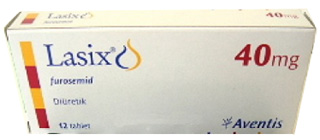Diuretics are substances found in tissues that help the body produce and excrete urine. High blood pressure often causes swelling, swelling of the legs and arms, and it is necessary to use drugs that stabilise the kidneys and remove excess fluid from the body. A popular diuretic is Lasix. Buy Lasix and other medicines in our online pharmacy, with delivery throughout United Kingdom. Low price, non-prescription delivery and a wide range of quality products are some of the main reasons why more than one million customers choose us.
Where To Buy Lasix In United Kingdom
To buy Lasix you don’t have to go to a pharmacy and waste a lot of time, you can always order the medicine quickly and easily on our website. Ordering online saves time and money.
Medicines Without Prescription In An Online Pharmacy
How to get a medicine without a prescription? Very simple: place an order on our website and we will send it to you as soon as possible. This will save you time spent going to the doctor, consulting a specialist over the phone and buying the medicine you need.
Affordable Product Pricing
Our pharmacy has a wide range of products that you can buy at an affordable price and save money. In addition, if you buy 2 or more products, there are discounts – our purchases are always quality, affordable and with good service!
Anonymity
A safe option for buying through the Internet pharmacy is cash on delivery, and we do this so that our customers do not have to worry about paying for the goods when they receive them. Fast delivery of medicines, the order is sent anonymously and your details about the items in the order will not be disclosed to third parties.
What Is Lasix?
Lasix is a diuretic that helps to remove excess fluid from the body and relieve swelling. The main ingredient is furosemide, which is fast-acting, with a diuretic effect that begins already after 1 hour. This drug must necessarily be assigned by a doctor, taking into account the individual characteristics of the organism (heart, liver, adrenal glands, hormonal background (especially cortisone).
Indications
The drug is prescribed against oedema:
- in chronic heart failure
- during pregnancy or childbirth
- in liver diseases (in combination with an aldosterone antagonist, if necessary).
Dosage and administration
The drug is prescribed on an empty stomach; the maximum daily dose of furosemide for adults is 1500 mg. Adult dosage is based on recommendations, taking into account the patient’s history:
- oedema in chronic heart failure – a daily dose of 20-50 mg per day, divided into 2-3 administrations;
- oedema in chronic renal failure – 40-80 mg as an initial dose which can be taken individually or divided into two doses;
- in haemodialysis patients, 250-1500 mg daily;
- in acute renal failure – initially to compensate for arterial hypotension, electrolyte and acid-base balance, hypovolemia
- in nephrotic syndrome – initial dose is 40-80 mg per day;
- in liver disease – the recommended starting dose is 20-80 mg per day; if administered intravenously, the initial single dose is 20-40 mg;
- in children – children over 10 kg body mass at 2 mg/kg body weight, the daily dose should not exceed 40 mg.
Contraindications for use
The medicinal product should not be administered in case of:
- hypersensitivity to furosemide and to other components of the medicinal product;
- allergy to sulphonamides
- hypovolaemia
- dehydration;
- renal failure in the form of anuria in the absence of therapeutic effect with the use of furosemide;
- patients with renal failure due to nephrotoxic or hepatotoxic drugs;
- severe hypokalaemia
- severe hyponatraemia;
- severe precomatose and comatose states associated with hepatic encephalopathy;
- during pregnancy;
- lactation.
Side effects
Treatment with Lasix may be accompanied by side effects:
- sensation of thirst
- headache
- confusion
- convulsions and muscle weakness
- tetany;
- abnormal heart rhythm
- nausea and vomiting;
- diarrhoea;
- acute pancreatitis;
- Allergic skin reactions (rash, pruritus, urticaria, erythema, dermatitis);
- Severe anaphylactic or anaphylactoid reactions;
- thrombocytopenia;
- eosinophilia
- leucopenia;
- fever.
Special Indications
During treatment, monitor patients with arterial hypotension, stenosis of blood vessels, diabetes mellitus, gout, severe liver disease, for premature infants, severe renal disease.
Furosemide should not be taken concurrently with aminoglycosides, chloral hydrate, sucralfate, risperidone, ACE inhibitors or angiotensin II receptor antagonists. Caution is advised in case of treatment with non-steroidal anti-inflammatory drugs, phenytoin, corticosteroids, antihypertensives.
How many times a day should Lasix be taken?
Depending on the prescribed dose, the tablets can be taken once or divided into 2 or 3 doses a day.
When does it start to work?
On therapy, the onset of the diuretic effect occurs as soon as one hour after taking the tablets. The duration of effect is 2-3 hours (up to 8 hours in case of reduced renal function).
How many days should Lasix be taken?
It is taken orally before meals in the morning; the starting dose for adults is 20-40 mg; if the effect is not sufficient, the dose is gradually increased to 80-160 mg daily, divided into 2-3 doses. Once the oedema has subsided, the dose is reduced and taken 1-2 days apart.
What Not To Eat On Furosemide Treatment
Furosemide should always be taken on an empty stomach; products that cause oedema should not be used during treatment.
Before or After Meals
Furosemide should only be taken on an empty stomach.
Morning or Evening
Furosed should be taken in the morning, before meals.


